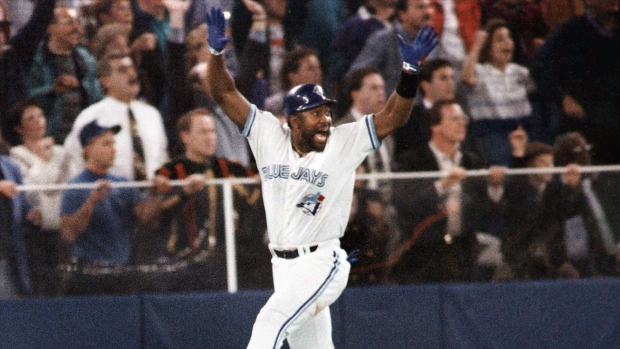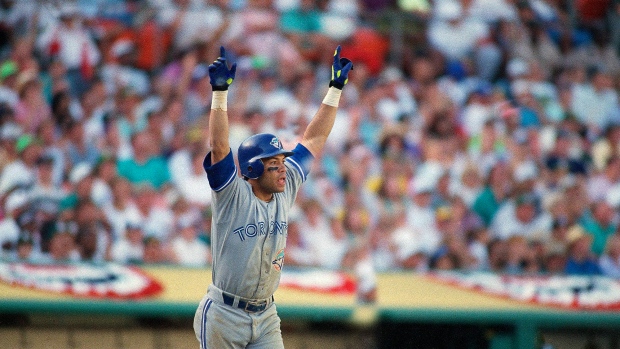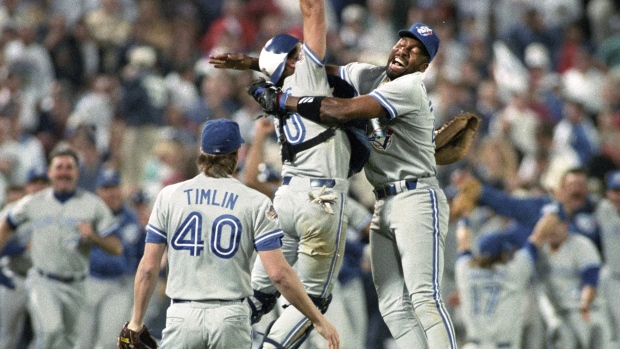Jun 30, 2017
TSN.ca's Canada 150: Back to back
For the decade prior to 1992, the Toronto Blue Jays were routinely a good team. In 1992 and 1993, they became the best team.
, TSN.ca Staff

For the decade prior to 1992, the Toronto Blue Jays were routinely a good team.
From 1982 to 1991, the team won an average of 89 games a season and captured three division titles.
But when it came time to take that next step, there was failure.
Up 3-2 in the 1985 American League Championship series, the Jays would drop two games at Exhibition Stadium to the eventual World Series champion Kansas City Royals.
The team fired manager Jimy Williams after starting the 1989 season 12-24. The team rallied to an American League East title under promoted hitting coach Cito Gaston, but the team was run over in five games in the ALCS by the eventual World Series champions (see a pattern emerging?), the Oakland A’s.
A 91-win season in 1991 was enough for an AL East title, but again the familiar narrative played out in the postseason as the Jays fell in five games to the eventual World Series champions, the Minnesota Twins.
So you could forgive Blue Jays fans if their excitement was somewhat muted when heading into the 1992 playoffs, even with what was quite possibly the best team in franchise history.
The Blue Jays won 96 games that year, after adding high-profile free agents Dave Winfield and Jack Morris to a core featuring Roberto Alomar, Joe Carter, John Olerud and Devon White. Starter David Cone came over from the New York Mets at the trade deadline to bolster a rotation with Morris, Jimmy Key, Todd Stottlemyre, Juan Guzman and Dave Stieb. The bullpen featured a lights-out late-inning combination of setup man Duane Ward and closer Tom Henke.
The Jays met up with the A’s in the playoffs once again. After the Jays jumped out to a 2-1 series lead, Oakland stormed ahead 6-1 in Game 4 thanks to a five-run third. A’s starter Bob Welch cruised into the eighth, but he was lifted when Alomar led off the inning with a double. With Jeff Parrett on in relief, Alomar stole third before Carter knocked him in with a single. Dave Winfield followed up with a single to advance Carter to third and end Parrett’s night.
A’s skipper Tony La Russa turned to his superstar closer, Dennis Eckersley, at that point. With a league-leading 51 saves that led to both the Cy Young and AL Most Valuable Player awards in ’92, Eckersley was just about as automatic as they came. The Jays, however, weren’t fazed.
Olerud greeted Eckersley with a single, scoring Carter and moving Winfield to third. A Candy Maldonado single scored Winfield and the Jays now trailed 6-4 with men on first and second with nobody out.
But then Eckersley did what he did so often that season. After inducing a fly ball from Kelly Gruber, he got Pat Borders to ground out. Then, with Ed Sprague pinch hitting for Manny Lee, Eckersley struck out the Jays infielder swinging and celebrated rather emphatically.
“You don’t get too many runs off of Dennis and he kinda did a little fist pump at our dugout and everything,” Carter recalled. “We were hot because it was like, okay, you’ve gotta pitch the ninth inning and we had the top of the lineup coming up.”
After the Jays came out of the bottom half of the eighth unscathed, Eckersley returned to the hill and promptly gave up a leadoff single to White.

The next batter was Alomar and on a 2-2 count, the Jays second baseman hammered a ball over the head of Ruben Sierra and over the right field fence at Oakland Coliseum. There was no doubt for Alomar as he immediately raised his arms in celebration right out of the box.
“I remember - me and Robbie kid about this – because I was on deck, when Robbie hits it, he throws his hands up and everything and I’m like, ‘Run!’ because I didn’t know if it was going to be out,” Carter said. “I didn’t know if he got it all. But I’m thinking from an RBI standpoint, I want him on third base so I can bring him in on a sac fly. But it was a big hit. That propelled us.”
In the other dugout, it was like a funeral.
“In the clubhouse, it was very, very quiet,” then-A’s starter Dave Stewart said. “It was about as solemn as it has been in our clubhouse after a loss. We were a club that was very, very confident and there was a different feeling and a different sound, obviously in our clubhouse after a loss.”
The Jays would go on to win the game 7-6 in 11 innings on a Borders sac fly and take the series in six games to advance to the franchise’s first ever World Series.
The team finally made good on years of promise, on years of coming so close. The Blue Jays were finally here and Alomar’s home run announced it.
“Once Robbie hit that home run, it really did get us over that hump,” Gaston said. “It got us over the hump because we had so many years when we got so close, but we’d go the other way.”
Across the field, Stewart saw a team whose time had come.
“They were a good baseball team and they had been climbing and they had been getting better,” Stewart said. “They had been building. You know, year after year, they were getting better. And so it was their time. It was there time to be there. It was their time to show the world what they could do and how they could play.”
And they did.
Flash forward 13 days and the Blue Jays were on the cusp of history. Leading the Atlanta Braves 4-2 in the 11th inning of Game 6 of the World Series, the Toronto Blue Jays were on the precipice of taking Major League Baseball’s top prize north of the 49th for the first time in history.
But there was the matter of closing out the series.
Key began the 11th by surrendering a single to Jeff Blauser. What appeared to be a double-play ball from Damon Berryhill was booted by shortstop Alfredo Griffin, leaving runners on first and second with nobody out. A Rafael Belliard sac bunt to first advance the runners before Brian Jordan’s grounder to Carter at first scored Blauser.
With a one-run lead and speedster Otis Nixon – who forced extra innings with a single in the ninth – coming up, Gaston had a decision to make.
“I had Mike Timlin in the bullpen warming up. I went to the mound just to check with Jimmy,” Gaston recalled. “You have pitchers who are honest with you and pitchers who will tell you stories to keep pitching, but some will tell you the truth. So I said, ‘Jimmy, are you okay with this?’ and he said, ‘You know what, Cito? This guy hits me pretty good. I don’t feel really comfortable with him.’ And that’s all he had to say.”
As the 26-year-old Timlin was about take the hill for the biggest appearance of his young career, Carter had one piece of advice.
“I brought in Timlin and we were all getting ready to disperse from the mound and Joe Carter was playing first base and Joe turned around and said, ‘Alright guys, don’t forget about the bunt,’” Gaston said. “I said that’s right and so he laid down a bunt and it looked like that ball was taking forever to get to first base, but it finally got there and they called him out.”

The perennial contenders were finally champions, but as the euphoria began to wear off over the winter, a new task emerged. After winning the first title in the club’s 16-year history, how could the Jays go about becoming the first repeat World Series winners since the New York Yankees in 1977 and 1978?
They would have to do so with tremendous roster turnover.
Winfield went on to sign with his hometown Twins. Henke joined the Texas Rangers. Gruber headed west to sign with the California Angels. Cone also went back to his hometown and linked up with the Royals.
“It was two different teams,” Gaston said. “I believe I’m right, but we switched out 14 players. So we switched out more than half our team. It was a playoff team, but you’ve got 11 players. You’ve gotta bring 14 more in who want to win, too, and we managed to do that. It wasn’t the same team. It wasn’t as strong as the ’92 team.”
But it was still a solid club as general manager Pat Gillick looked for reinforcements. With Winfield gone, Gillick found a new designated hitter by persuading Paul Molitor to leave the Milwaukee Brewers after 15 seasons. To bolster the rotation, Gillick looked to an old foe.
“I remember Pat saying that they had a chance to lose David Cone and, if they did, they were going to come after me,” Stewart recalled. “But he said they were going to negotiate honestly to try and bring him back and they did, but it didn’t work out for him and so he called me and said you’re the guy on our list. We want to bring you here and he went into negotiations with my agent and, quite frankly, he stole me from the Yankees because I was ready to sign with the Yanks.”
Even with a solid rotation featuring the addition of Stewart, the 1993 Jays used their bats to batter the opposition into submission.
“What we did, we just outscored everybody, which is almost impossible in baseball to do,” Gaston explained. "But we did do it and we did it because John Olerud finished first in the league in hitting, Paul Molitor finished second and Robbie Alomar finished third. We scored a lot of runs that year, but I didn’t have the same bullpen. We weren’t playing seven-inning ballgames like we did before because the only guy I had in the bullpen at that particular time was Duane Ward. Tom Henke was gone. We had a different third baseman in Ed Sprague – he did a good job, too – and we had a different shortstop. So it was a different team and it wasn’t as a good a team as far as an all-around [team], but it was good enough to win and we had a lot of guys with heart.”
And win they did.
Their 95 wins were enough to win the AL East by seven games over the Yankees. The Jays dispatched the Chicago White Sox in six games in the ALCS with Stewart getting the win in the decider and being named MVP of the series.
In the World Series, the Jays met the Philadelphia Phillies and Jays fans know what happened next. They know where they were and who they were with. They remember it like it was yesterday.
Game 6. Bottom of the ninth. Phillies leading 6-5. Rickey Henderson on first. Molitor on second. Mitch Williams on the hill. Joe Carter at the dish with a 2-2 count.
“What I remember so much about it is that I had put Alfredo Griffin in the game and Alfredo was hitting behind Joe at that particular time and I had to make a decision if I was going to pinch-hit for him,” Gaston said. “I was sitting there thinking about it and I was looking at my stats and actually, Alfredo had good stats against [Mitch Williams]. Darnell Coles was sitting on the bench and he hadn’t played in one game – and I apologize to him every time I see him about that – and I was thinking okay, I’m going to go with Alfredo. As soon as I came out of my mind to think that, there’s the crack of the bat and people jumping in front of me. I never saw the ball leave the ballpark. But you talk about relief. If you want to spell relief, you can spell it ‘home run.’”
Stewart started Game 6 and was in the clubhouse during the ninth inning.

“I was watching it on TV and I just heard the stadium go crazy,” Stewart said. “It went absolutely nuts and obviously I was able to get out and enjoy my teammates. It was an unbelievable feeling. I had never been part of a win like that in a playoff or any World Series.”
For Gaston, two World Series wins in two years came after so many years of being this close to glory and they couldn’t have come sooner.
“I can remember so many times here as a coach and doing some of the [Canada-wide] caravans,” Gaston said. “Tom Cheek, along with Jerry Howarth would have video of us getting close, but not getting over that hump and it was kind of heartbreaking to sit there and watch that day in and day out.”
Stewart says that win in ’93 was the highlight of his career and made even more special by the fans in Toronto.
“All-time best, all-time best without a doubt,” Stewart said. “Until you play here, you really don’t know it, but when I came here…all the talk around town about the baseball team – I knew it was a special team.”
On the back of two now-famous home runs, that special team remains revered in Toronto and the rest of Canada more than a quarter-century later.

